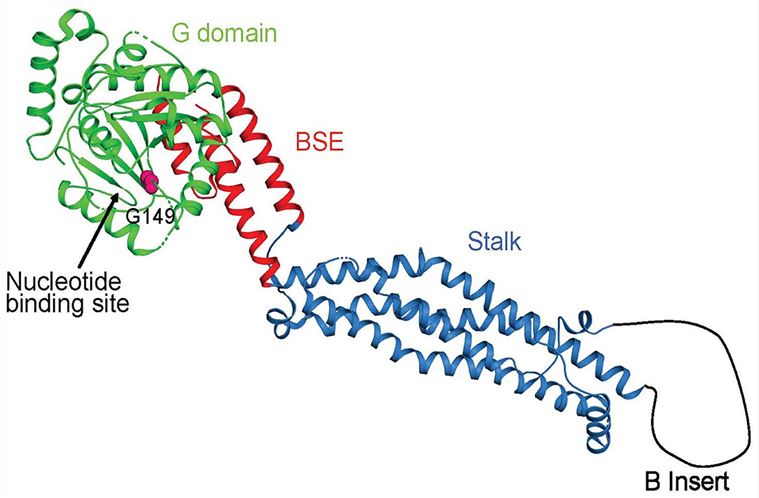What is DNM1L Protein
See All DNM1L Protein Products
In the field of cell biology, the DNM1L protein plays a key role in coordinating important processes within cells.
DNM1L (or Dynamin-1-like protein) is a cornerstone of mitochondrial dynamics. This GTPase is found primarily in the outer mitochondrial membrane and controls the delicate balance between mitochondrial fission and fusion. The modular structure of DNM1L consists of a GTPase domain, a middle domain, a pleckstrin homology (PH) domain, a GTPase effector domain (GED), and a proline-rich C-terminal domain.
 Figure 1. Crystal structure of DNM1L in ribbon representation (Wei, Y. F., et al. 2021)
Figure 1. Crystal structure of DNM1L in ribbon representation (Wei, Y. F., et al. 2021)The Function of DNM1L Protein
The main task of DNM1L is to regulate mitochondrial fission, an important process for maintaining mitochondrial health. As mitochondria continue to undergo fusion and fission, DNM1L assembles into helical structures around the outer mitochondrial membrane. GTP hydrolysis induces conformational changes that promote mitochondrial fission. This dynamic interaction enables cells to generate new mitochondria, isolate damaged mitochondria, and adapt to different energy needs.
DNM1L-Related Diseases
The effects of DNM1L dysregulation are seen in a variety of human diseases. In neurodegenerative diseases such as Alzheimer's and Parkinson's disease, abnormal mitochondrial fission driven by DNM1L dysfunction leads to neuronal degeneration. Cardiovascular disease, exemplified by ischemia-reperfusion injury, demonstrates the relevance of balancing mitochondrial dynamics. The link between DNM1L and these diseases emphasizes its central role in cellular homeostasis.
DNM1L Related Signaling Pathways
DNM1L is intricately intertwined with various signaling pathways that orchestrate cellular responses. Phosphorylation events orchestrated by proteins such as DRP1 and CDK1 regulate DNM1L activity, determining its ability to initiate mitochondrial fission. Mitochondrial fission factors (MFFs) play a critical role in recruiting DNM1L to specific mitochondrial sites, orchestrating its helical assembly, and ensuring precise fission.
Furthermore, cellular stress responses, such as the unfolded protein response (UPR) and oxidative stress, add to the complexity of DNM1L regulation. These pathways regulate the expression and activity of DNM1L, revealing its adaptability in response to different cellular stresses.
Applications of DNM1L in Biomedical Research
Uncovering the role of DNM1L in cell physiology opens promising avenues for biomedical research and therapeutic intervention.
- Mitochondrial Medicine
DNM1L emerges as a potential therapeutic target for mitochondrial diseases. By fine-tuning DNM1L activity, the researchers aimed to restore mitochondrial dynamics, providing new strategies to mitigate the effects of mitochondrial dysfunction.
- Neuroprotection
Manipulating DNM1L is a promising neuroprotective strategy in neurodegenerative diseases. Therapies targeting DNM1L activity may halt the progression of diseases such as Alzheimer's and Parkinson's by restoring mitochondrial balance.
- Cardioprotection
DNM1L modulation holds promise for mitigating cardiovascular disease. By maintaining balanced mitochondrial dynamics, interventions targeting DNM1L may provide cardioprotection, particularly in conditions such as ischemia-reperfusion injury.
- Cancer Therapeutics
Abnormal mitochondrial dynamics in cancer cells opens the door to innovative cancer therapeutics. Targeting DNM1L may selectively disrupt energy metabolism in cancer cells, providing a new approach to cancer treatment.
DNM1L serves as a key player in the intricate cellular dynamics, coordinating mitochondrial fission and influencing multiple physiological processes. From its modular structure to its complex involvement in signaling pathways and biomedical applications, DNM1L has attracted scientific attention and holds the promise of advancing the development of precision medicine.
Recommended Products for DNM1L Protein
| Cat.# | Species | Product name | Source (Host) | Tag |
|---|---|---|---|---|
| DNM1L-2785H | Human | Recombinant Human DNM1L Protein, GST-tagged | Wheat Germ | GST |
| DNM1L-199HFL | Human | Active Recombinant Full Length Human DNM1L Protein, C-Flag-tagged | Mammalian cells | Flag |
| DNM1L-2471H | Human | Recombinant Human DNM1L Protein, Myc/DDK-tagged, C13 and N15-labeled | HEK293T | Myc/DDK |
| DNM1L-2584H | Human | Recombinant Human DNM1L Protein (1-710 aa), His-Myc-tagged | E.coli | His/Myc |
| DNM1L-4043HF | Human | Recombinant Full Length Human DNM1L Protein, GST-tagged | In Vitro Cell Free System | GST |
| DNM1L-4736M | Mouse | Recombinant Mouse DNM1L Protein | Mammalian Cell | His |
| Dnm1l-2618M | Mouse | Recombinant Mouse Dnm1l Protein, Myc/DDK-tagged | HEK293T | Myc/DDK |
| DNM1L-1923R | Rat | Recombinant Rat DNM1L Protein | Mammalian Cell | His |
| DNM1L-11163Z | Zebrafish | Recombinant Zebrafish DNM1L | Mammalian Cell | His |
| DNM1L-3555C | Chicken | Recombinant Chicken DNM1L | Mammalian Cell | His |
Reference
- Wei, Y., Qian, M. Case Report: A Novel de novo Mutation in DNM1L Presenting With Developmental Delay, Ataxia, and Peripheral Neuropathy. Front Pediatr. 2021, 9: 604105.

